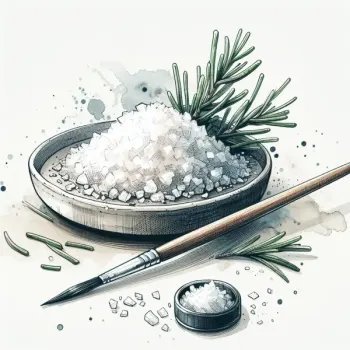
Substitutes for sea salt in cooking include table salt, Himalayan pink salt, kosher salt, potassium chloride salt substitutes, and herb blends, each suitable for various recipes and dietary preferences. Adjust quantities based on the substitute's potency and your taste.
In baking, table salt can be used as a direct substitute for sea salt. Due to its fine texture, it disperses more evenly throughout doughs and batters. Use about half the amount of sea salt called for, since it's more potent. This will help maintain the intended flavor balance. Brands like Morton are commonly used.
Himalayan pink salt can also be used in baking. It offers trace minerals and a slightly different flavor profile. Use it in a 1:1 ratio with sea salt, but keep in mind it can be slightly less salty, so adjust to taste. Popular brands include Sherpa Pink and The Spice Lab.
For general cooking, kosher salt can replace sea salt in a 1:1 ratio by volume, but because it's less dense, you might need more by weight. It dissolves well and is a kitchen staple for professional chefs. Brands like Diamond Crystal are preferred for their consistency.
Himalayan pink salt is a mineral-rich alternative that works well in most cooking applications. Use it in the same amount as sea salt, but start with a little less and adjust to taste, as its flavor can be more intense. Brands like Sherpa Pink are widely available.
Kosher salt is a great substitute for sea salt for seasoning and finishing dishes. It has a flaky, coarse structure that dissolves quickly. It's less dense than sea salt, so you may need to use more. A good starting point is a 1:1 ratio, adjusting to taste. Brands like Diamond Crystal and Morton are popular choices.
Table salt, with its fine granules, is the most common alternative to sea salt. It's more concentrated, so use less when substituting — start with half the amount of sea salt called for and adjust to taste. Iodized varieties are available for those looking to add iodine to their diet. Morton and Saxa are well-known brands.
For those on low-sodium diets, potassium chloride can be used as a salt substitute. It has a salty flavor but can have a slightly bitter aftertaste. Use it sparingly at first, as it can overpower other flavors. Popular brands include Nu-Salt and Morton Salt Substitute.
Herb blends like Mrs. Dash offer a way to flavor dishes without salt. They can be used liberally, but since they lack the salty taste, they may not be suitable for all recipes. These blends are a great way to add flavor while managing sodium intake.

Your ultimate Recipe Box, Meal Planner, and Cooking Class all in one
| Recipe Category | Substitutes |
|---|---|
| Baking | Table Salt, Himalayan Pink Salt |
| Cooking | Kosher Salt, Himalayan Pink Salt |
| Seasoning and Finishing | Kosher Salt, Table Salt |
| Health-Conscious Recipes | Potassium Chloride Salt Substitute, Herb Blends |
While sea salt is a unique and flavorful ingredient, there are several substitutes that can be used across a variety of recipe categories. From kosher salt to herb blends, these alternatives can help you adapt your recipes to suit dietary needs or compensate for a lack of sea salt. Remember to adjust quantities based on the potency of the substitute and personal taste preferences.